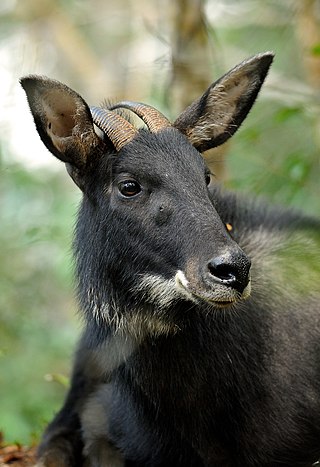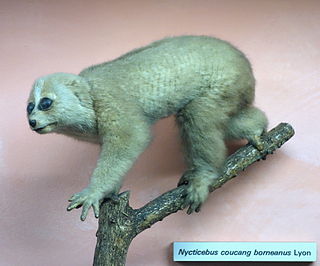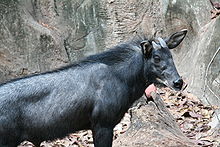
Tahrs or tehrs are large artiodactyl ungulates related to goats and sheep. There are three species, all native to Asia. Previously thought to be closely related to each other and placed in a single genus, Hemitragus, genetic studies have since proven that they are not so closely related and they are now considered as members of three separate monotypic genera: Hemitragus is now reserved for the Himalayan tahr, Nilgiritragus for the Nilgiri tahr, and Arabitragus for the Arabian tahr.

The Japanese serow is a Japanese goat-antelope, an even-toed ungulate. It is found in dense woodland in Japan, primarily in northern and central Honshu. The serow is seen as a national symbol of Japan, and is subject to protection in conservation areas.

The Sumatran tiger is a population of Panthera tigris sondaica on the Indonesian island of Sumatra. It is the only surviving tiger population in the Sunda Islands, where the Bali and Javan tigers are extinct.

The Sumatran elephant is one of three recognized subspecies of the Asian elephant, and native to the Indonesian island of Sumatra. In 2011, IUCN upgraded the conservation status of the Sumatran elephant from endangered to critically endangered in its Red List as the population had declined by at least 80% during the past three generations, estimated to be about 75 years. The subspecies is preeminently threatened by habitat loss, degradation and fragmentation, and poaching; over 69% of potential elephant habitat has been lost within the last 25 years. Much of the remaining forest cover is in blocks smaller than 250 km2 (97 sq mi), which are too small to contain viable elephant populations.

The mainland serow is a serow species native to the Himalayas, Southeast Asia and China.

The Sunda clouded leopard is a medium-sized wild cat native to Borneo and Sumatra. It is listed as Vulnerable on the IUCN Red List since 2015, as the total effective population probably consists of fewer than 10,000 mature individuals, with a decreasing population trend. On both Sunda islands, it is threatened by deforestation. It was classified as a separate species, distinct from the clouded leopard in mainland Southeast Asia based on a study in 2006. Its fur is darker with a smaller cloud pattern.

The Javan blue robin is a species of bird in the family Muscicapidae. It is endemic to the Indonesian island of Java. Its natural habitat is subtropical or tropical moist montane forests. The Sumatran blue robin was formerly considered a subspecies of M. diana, with both the Javan and Sumatran subspecies being grouped under the name Sunda robin.

The Sumatran laughingthrush, also known as the black-and-white laughingthrush, is a member of the family Leiothrichidae. It was formerly treated as a subspecies of the white-crested laughingthrush, but unlike that species the plumage of the Sumatran laughingthrush is blackish-brown and white.

The serows are four species of medium-sized goat-like or antelope-like mammals of the genus Capricornis. All four species of serow were until recently also classified under Naemorhedus, which now only contains the gorals.

The Indochinese serow is a vulnerable goat-antelope, a subspecies of the mainland serow, native to Cambodia, Laos, Myanmar, Thailand and Vietnam.

The red serow, also called the Burmese red serow is a goat-antelope thought to be native to southern Bangladesh and northern Myanmar. It has been sometimes been considered a subspecies of C. sumatraensis. In the northeastern part of India, the red serow occurs widely in the hills south of the Brahmaputra river. although the IUCN states that this species is recorded with certainty only from Myanmar, in Kachin State, and that records in India refer to the Himalayan serow.

The Himalayan serow, also known as the thar, is a subspecies of the mainland serow native to the Himalayas. It was previously considered its own species, as Capricornis thar. It is the official state animal of the Indian state of Mizoram.
The Sumatran muntjac is a subspecies of Indian muntjac in the deer family which can be the size of a large dog. It was discovered in 1914, but had not been sighted since 1930 until one was snared and freed from a hunter's snare in Kerinci Seblat National Park, Sumatra, Indonesia in 2002. Two other Sumatran muntjac have since been photographed in the park. The Sumatran muntjac was placed on the IUCN Red List in 2008, but was listed as Data Deficient, as taxonomic issues are still unresolved. The distribution of the taxon is also uncertain and may be more extensive than suggested. It is possible that some previous sightings of the common muntjac in Western Sumatra were the Sumatran muntjac.

Nycticebus borneanus, the Bornean slow loris, is a strepsirrhine primate and a species of slow loris that is native to central south Borneo in Indonesia. Formerly considered a subspecies or synonym of N. menagensis, it was promoted to full species status in 2013 when a study of museum specimens and photographs identified distinct facial markings, which helped to differentiate it as a separate species. It is distinguished by its dark, contrasting facial features, as well as the shape and width of the stripes of its facial markings.

The Northern Sumatran rhinoceros, also known as Chittagong rhinoceros or northern hairy rhinoceros was the most widespread subspecies of Sumatran rhinoceros, as well as the only known subspecies native to mainland Asia.

Chiang Dao Wildlife Sanctuary is a protected area in Chiang Mai Province, Thailand. Established on 25 August 1978, the sanctuary covers 521 km2 of the Doi Chiang Dao and southern mountainous regions of the Daen Lao Range, north of the Thanon Thong Chai Range. The tallest summit is 2,175 m high Doi Chiang Dao.
The black Sumatran langur is a species of monkey in the family Cercopithecidae. It was formerly considered a subspecies of the Sumatran surili, Presbytis melalophos but genetic analysis revealed that these are separate species. The black Sumatran langur is native to the island of Sumatra in Indonesia. It is listed as endangered by the IUCN due primarily to deforestation, and also due to animals taken for pets.

The northern hog badger is a species of mustelid native to South and East Asia.
The Sumatran hog badger is a species of mustelid endemic to the island of Sumatra in Indonesia.

The Sumatran shortwing is a species of bird in the Old World flycatcher family Muscicapidae. It is endemic to the island of Sumatra in western Indonesia where it favours montane forest.

















